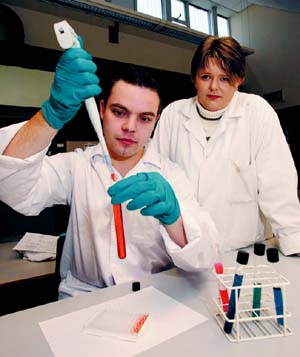| 2004 |

|
YEAR BOOK |
Limerick Institute of Technology
|
Molecular Imprinting at L.I.T.
|

Molecular Imprinting produces a polymer that displays molecular recognition for a chosen analyte. The polymer is synthesized in the presence of the analyte, which acts as a print molecule. In the presence of functional monomers, excess cross-linking agent, a non-aqueous solvent and initiator, polymerization occurs. The print molecule is then extracted producing a template cavity. Physically stable, resistant to mechanical stress, high pressure and elevated temperature, MIPs possess an imprinted memory of more than a hundred times without loss of memory. These attributes make a MIP an ideal analytical material compared with perishable biological matrices.
At present, two research projects are under way in the Institute developing MIPs as highly selective sorbents. The first of these projects is focusing on developing this method of extraction for the benzodiazepine family of drugs. These are a large class of drugs that are commonly used by the community as minor tranquillizers � e.g. Valium (Diazepam), hypnotics, muscle relaxants, and anti-convulsants. However, young illicit drug users also abuse these drugs. Since benzodiazepines are commonly seen in clinical and forensic cases, their measurement in specimens is widely practiced.
MIPs have been designed and synthesized for oxazepam, the main metabolite of the benzodiazepines, and diazepam. These MIPs have been successfully applied as solid phase extraction sorbents. Further members of the benzodiazepine family are now under consideration. High performance liquid chromatography (HPLC) and gas chromatography with mass spectroscopy detection (GC/MS) methods have also been developed for several members of this class of drug.
Further applications of these MIPs are also under development in the Institute. One such application is the analysis of Aflatoxin M1 in milk and milk based products using mycotoxin templates for MIP production. Aflatoxins are known hepatocarcinogens (causing liver cancer) and their presence in consumables is both of medical and economic concern. The Aflatoxin specific MIPs will be used to extract these toxins from real life samples which can be quantified using HPLC and fluoremetric analysis.
Contact: Dr Siobh�n Moane, Department of Applied Science, L.I.T.; E-mail: [email protected] ;
Dr Ann Murphy, Department of Applied Science, L.I.T.; E-mail: [email protected] ;
Sin�ad Hennessy BSc, Postgraduate Research, L.I.T.; E-mail: [email protected] ;
David Fennell BSc, Postgraduate Research, L.I.T.; E-mail: [email protected]